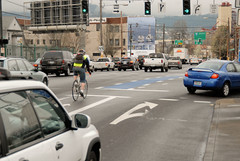The intersection of NE Broadway and N Williams is notorious among many Portlanders.
The intersection (view on Google Maps) is a high-volume, high-speed, five-lane, one-way thoroughfare with a bike lane sandwiched between two right-turn lanes (one is also a through lane). That makes it bad enough, but several other factors make it even more of a nightmare;
- it’s just yards from a freeway on-ramp,
- it’s very popular for bike commuters headed into downtown Portland,
- N. Williams is a major north-south bikeway,
- there’s a gas station on the northeast corner,
- and the intersection’s future will likely include a Streetcar line.
Under the existing configuration, bikes must merge into motor vehicle traffic to get into the bike lane one block prior to the intersection, than stay aware of (and away from) right-turning cars once they get to Williams.
Given those complexities, it’s no surprise the intersection has been on the radar of the City’s bike planners for many years. Over a decade ago, the Office of Transportation included it in a list of ten intersections to receive their innovate ‘blue bike lane’ treatment.

Broadway and Williams was once again recognized as a dangerous intersection last winter when PDOT first embarked on their “bike box intersection safety project.” As one of the 14 intersections identified, it was initially slated to receive a bike box similar to the one recently installed at SE Hawthorne and 7th.
But now the bike box is on hold and PDOT is taking a closer look at the location. Last month they had an extensive engineering analysis performed by an outside consultant to help them weigh their options (the study looked at a large area around the Rose Quarter, not just this one intersection).
Currently, the two options on the table are a bike box and a bicycle-only traffic signal.
In the first option, illustrated in the graphic below, a bike box would be placed in the through/right lane (this option has not changed — except for color choice — since November).

(Graphic: PDOT)
This configuration would be helpful during red light situations, but it offers little improvement over existing conditions during a green light, when right-turning motor vehicles would still be to the left of the bicycle lane. This treatment also still requires bikes to merge into the lane one block prior to the intersection.
The other option being considered by PDOT is to move the bike lane curbside and add a bicycle-only traffic signal:

(Graphic: PDOT)
This option would also re-configure Broadway into two through lanes and two right-turn only lanes (in addition to the bike lane).
According to PDOT, this option would be coupled with a separate signal phase for bikes so that bike traffic does not have green at the same time the right turn lanes do. The signal would also have special detectors in the lane to sense when a bike is present. The signal might also be an “exclusive phase”, meaning all vehicles at the intersection would receive a red light when the bike light is green.
A study done by PDOT consultants called this second option, “promising” and it is currently undergoing further detailed analysis.
Clearly, this intersection presents many design issues for City engineers and planners. They have to figure out not only what is the safest and most comfortable treatment for all road users, but they must also take into account any significant decrease in traffic volume a new design would lead to. I don’t envy their task.
Whatever is done at this intersection to improve bike safety, it will be a welcome change for the hundreds of cyclists who use it each day and it will be one less roadblock in the way of the many Portlanders who would like to ride, but because of intersections like this, leave the bike at home.
What about you? Can you share your experiences? What do you think PDOT can do to improve bike safety at this location?



